Product guides
Safer garden sprays
Janet Luke

Walk into any garden centre and you’ll see dozens of products with which you can unleash chemical warfare on the insects living in your garden!
However, toxic pesticides and herbicides are harmful to the environment, to plant and animal life, and to nature’s food chain. Plus many garden pests become immune to these chemicals, leading gardeners to use more and more powerful sprays to control them.
Chemical pesticides can also present a danger to children. When children play outside they are at risk of toxic residues being transferred to their feet and hands and clothes.
Thankfully these days there is a growing selection of more natural or organic sprays which the home gardener can choose from. Arguably natural control methods are not as effective as more orthodox treatments, but with a little more time and effort they will control pests.
The following sprays are still pesticides and should still be used with caution and respect, yet they differ from mainstream products. They are derived from naturally occurring ingredients and once applied are quickly broken down by the environment. These organic pesticides will repel, and in many cases kill pests, but remember they will kill beneficial insects as well as the ones you are trying to target – so as with all sprays they do need to be used with caution.
Tui Organic Eco-Pest
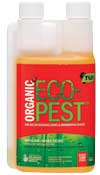
$24.99
The label on this Australian-made product says it is “for the control of two-spotted mites, aphids, whitefly and scale and for helping control powdery mildew”, but it’s suitable for treating all insect infestations. The spray is made from just over 85 per cent canola oil in the form of a concentrate that mixes easily with water. The label claims that Eco-Pest contains three powerful plant oils but the other two must be in very minor traces because they are not mentioned by name. The mixed spray has a pleasant eucalyptus smell, so maybe that is one of the mystery oils.
Tui recommends diluting at 5ml (about a teaspoon) per litre for insects and 10ml per litre for scale, so the 500ml bottle is good for up to 100L of spray. It is recommended to spray again 3-5 days after the first application.
I tried the spray on aphids and scale and within 24 hours it had knocked down around 70 per cent of the bugs.
Kiwicare Organic Super Spraying oil
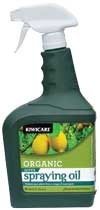
$16.99
This New Zealand-made spray comes in a handy 1L ready-to-spray bottle. The product is Biogro certified. Reviewing the Safety Data Sheet for the product it is difficult not to note that the product contains more than 90 per cent water and less than 5 per cent of the active mineral oil. Seems a fairly expensive bottle of water! The mineral oil is paraffin oil which is a byproduct of the distillation of petroleum to produce gasoline.
It is important to read the fine print, which says not to apply during strong sunshine or hot weather – oil applied during these conditions causes the leaves and fruit to scorch causing brown spots on the foliage and fruit.
I tried this spray on whitefly on the tomatoes in my greenhouse. It did decrease the whitefly population but the following morning there were still a good population of these insects flying when disturbed. Regular applications would be required for a good effect.
Wallys Neem Tree Oil
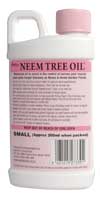
$19
Neem tree oil is a natural extract from the kernels of the neem tree. The neem oil acts on insects that digest or come into contact with the oil. The oil is absorbed into the foliage of the plant then when the foliage is eaten by the insect it absorbs the neem. Trials done in nurseries in New Zealand and overseas have found neem oil to be effective in the control of whitefly, caterpillars, mites, scale and aphids. It will not harm beneficial creatures such as bees or earthworms. Like other oils it is mixed with water before being applied.
Neem oil won’t kill insects immediately as it is not a poison – instead it affects the pest insect’s ability to eat or develop.
It lasts on the plant for around seven days until it is broken down by UV light. Interestingly there is a small sticker on the product packaging which states that this product is not registered in NZ for use on or around food crops, but it’s likely that this is due to the cost of getting the product registered as other neem oils have been approved.
It is recommended not to apply in strong sunlight and best to use late in the day for a quicker knock down. The liquid is brown and has a unique but not offensive odour.
Applied to an aphid infestation the population started to decrease after five days. This product is best used as a preventive rather than a quick-acting product when you require immediate effect. It can be mixed with pyrethrum spray to increase its effectiveness.
Kiwicare Organic Insect Control with Pyrethrum
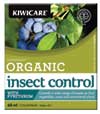
$28
Kiwicare Organic Insect Control with Pyrethrum contains a concentrate solution of pyrethrum which the label says “will control a wide range of insects on fruit, vegetables, roses and ornamental plants.” This product comes with a handy measuring cup and will make up to 60L of spray.
The spray’s base is pyrethrum which is a naturally occurring pesticide in daisies. The good thing about these sprays is they are quickly broken down by UV light in as little as two hours. For this reason it is recommended to spray plants at dusk so the spray can be active during the night.
After following the dilution directions I sprayed a passion fruit vine which was covered with passion vine hoppers and young shield beetles. There was a marked effect with few insects left when checked 48 hours later.
It is important to note that pyrethrum is highly toxic to bees and fish. Avoid spraying it on any flowering plants during daylight hours and do not spray near ponds or fish tanks.
Wallys Key Pyrethrum
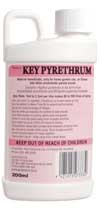
$19.99
This 200ml bottle can make up to 200L of pyrethrum spray and at $19.99 it seems good value for money. I got similar good results using this product as I did using the Kiwicare product.
Diatomaceous Earth
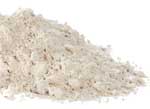
$16-$19 for 500gm from www.greenurbanliving.co.nz or www.denz.co.nz
This fine white powder is ground-up fossilised single cell algae, mined from freshwater lake beds, mostly in America. Under a microscope each particle has extremely sharp and jagged edges. When this dust comes into contact with insects it pierces their exoskeleton and they die of dehydration. Thus it acts as a mechanical control rather than a chemical control.
To apply you need to dust foliage and reapply after rain or heavy dew. You can also make it into a dilute spray and apply with a wide gauge spray nozzle. If you are using on food production crops it is important to only use food grade diatomaceous earth rather than the industrial grade which is commonly used in pool filters and the wine industry. Avoid breathing the dust.
After wetting plants with a hose I apply diatomaceous earth using a simple shaker tin. After five days you should expect to see a marked decrease in the amount of pests. For best results apply every week to any problem plants or areas in your garden and remember you will need to reapply after any rain.
Homemade spraying oil
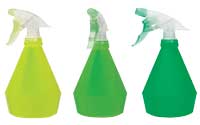
This homemade spraying oil is based on store-bought oils and is made with easy-to-find home ingredients.
When used it had very similar results to commercial oils regarding insect knockdown.
To make it, mix 20ml of canola oil with 20ml of Dr Bronners Natural Soap. Add 250ml of warm tap water and shake well. Pour into a spray bottle and spray insects. Reapply the next day.
Homemade garlic spray
I have been using this recipe for many years. I find it a good way to get rid of old garlic paste. For bad infestations it does require repeat applications, but it is effective. The milk helps the solution stick to the leaves and can even withstand a light shower. Milk may also give some protection against fungal diseases. Remember to wash hands afterwards as you don’t want to rub your eyes with Tabasco sauce on them!
To make it, place 1 heaped tablespoon of crushed garlic, 20 drops of your hottest Tabasco sauce and 20ml of milk in a small container. Add 250ml of warm tap water and let the solution infuse for 24 hours. Strain into a spraying bottle and apply.
What are spraying oils?
Oils have different effects on pest insects. The most important is that they block the air holes (spiracles) through which insects breathe, causing them to die from asphyxiation. In some cases, oils also may act as poisons, interacting with the fatty acids of the insect and interfering with normal metabolism. Oils may also disrupt how an insect feeds, a feature that is particularly important in the transmission of some plant viruses by aphids.
Precautions
When applying any insect control spray follow these important health measures.
- Only spray on still days
- Always wear gloves
- Avoid spraying at head height or at angles where the spray may fall on you
- Adjust the spray nozzle so that a fine spray is produced rather than large droplets which are less effective
- Wash hands and change clothes before eating
- Do not let any spray run off into waterways or on to food utensils including pet bowls
- Read and following instructions carefully, particularly those about ‘withholding periods’ – the time you need to wait before consuming food crops that have been sprayed
